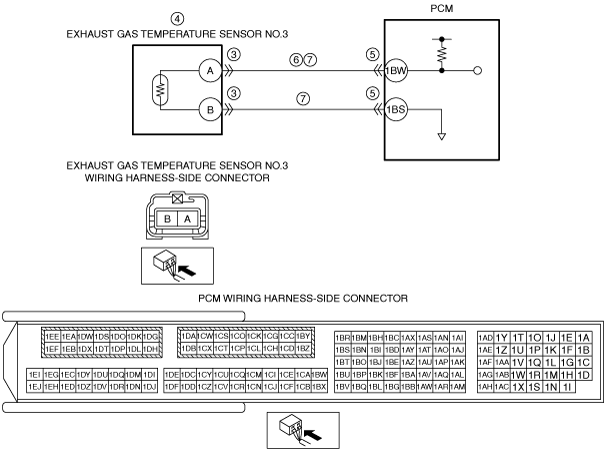DTC P242D:00
Exhaust gas temperature sensor No.3 circuit high input
DETECTION CONDITION
• The PCM monitors the exhaust gas temperature sensor No.3 signal. If the PCM detects that the exhaust gas temperature sensor No.3 voltage at the PCM terminal 1BW is above 4.96 V for 10 s, the PCM determines that the exhaust gas temperature sensor No.3 circuit has a malfunction.
-
― Battery voltage: 8—20 V― Between the elapsed time of 14 to 70 min. after the ignition is switched on (engine on).― Engine speed: above 700 rpm― Engine coolant temperature: above 60 °C {140 °F}― Intake air temperature: −10 °C {14 °F}― Charge air temperature: −10 °C {14 °F}― Vehicle speed: above 25 km/h {16 mph} continues for 10 min or more― Fuel injection amount: 20 mm3/st or more― Total fuel injection amount: 400,000 mm3 or more― The following DTCs are not detected:
-
• IAT sensor No.1: P0112:00, P0113:00• ECT sensor: P0117:00, P0118:00• IAT sensor No.2: P007C:00, P007D:00• VSS: P0500:00
-
MONITORING CONDITIONS
Diagnostic support note
• This is a continuous monitor (CCM).
• The check engine light illuminates if the PCM detects the above malfunction condition during the first drive cycle.
• FREEZE FRAME DATA (Mode 2)/Snapshot data is available.
• DTC is stored in the PCM memory.
FAIL-SAFE FUNCTION
• PCM restricts engine torque.
• Inhibits the EGR control.
• Inhibits the diesel particulate filter regeneration control.
• Inhibits engine-stop by operating the i-stop function.
• PCM restricts engine-transaxle integration control.
POSSIBLE CAUSE
• Exhaust gas temperature sensor No.3 connector or terminals malfunction
• Exhaust gas temperature sensor No.3 malfunction
• PCM connector or terminals malfunction
• Short to power supply in wiring harness between exhaust gas temperature sensor No.3 terminal A and PCM terminal 1BW
• Open circuit in wiring harness between the following terminals:
-
― Exhaust gas temperature sensor No.3 terminal A—PCM terminal 1BW― Exhaust gas temperature sensor No.3 terminal B—PCM terminal 1BS
• PCM malfunction
